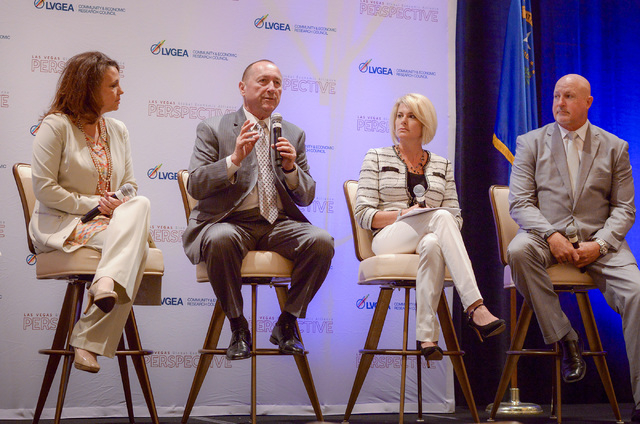Economy likened to mid-2000s — but officials say this time is different

Tourism is booming, the population is growing and the economy is heating up — a combination of factors that eventually led to Great Recession in 2007 and 2008.
But a panel of forecasting experts speaking at an event heralding the publication of the 35th edition of “Las Vegas Perspective” on Tuesday say the conditions are different now than they were seven years ago.
“The focus is on steady growth,” said Nat Hodgson, executive director of the Southern Nevada Homebuilders Association, at the event sponsored by the Las Vegas Global Economic Alliance at the Four Seasons. “I think we’ve learned a few things from the past.”
About 500 people attended the event at which the alliance released the 178-page resource book filled with demographic and economic information about Southern Nevada and had a forecast session the economic development organization conducted for the first time.
Stephen Miller, a professor the University of Nevada, Las Vegas Lee Business School, said the general outlook for Southern Nevada is positive, but diversification of the economy is an ongoing concern.
Miller said that while state officials have made efforts to diversify the state’s economy under a plan undertaken by Gov. Brian Sandoval four years ago, it’s a slow process, and tourism and gaming continue to drive the state’s economic engine.
Because casinos are open all over the country, the state can no longer rely on gaming to carry the economy. Panelist Chris Jones, an analyst with the Union Gaming Group, said that while slot machine revenue has stabilized in the state, volatile baccarat revenue continues to plummet.
Even though Las Vegas is making a pitch for international visitors, Jones doesn’t expect the world to flock to Las Vegas from the world’s leading gaming venue, Macau, which is suffering its own gaming downturn as a result of restrictions from the central Chinese government.
OPTIMISM TEMPERED WITH REALITY
Keynote speaker Jeremy Aguero, a principal with Applied Analysis, offered an optimistic outlook tempered with the reality of some of the challenges the region faces.
Aguero said he is excited about the progress Southern Nevada has made, but noted that there are still concerns about water development, the high cost of health care, the lack of qualified doctors and nurses, continued declines in gaming revenue, the continued drain on retail sales to online vendors and the lack of funding dedicated to education in the state.
Four officials behind four major Southern Nevada development projects that have begun or are on the horizon gave updates in a second panel.
Rossi Ralenkotter, president and CEO of the Las Vegas Convention and Visitors Authority, gave new details of the planned $2.3 billion Las Vegas Global Business District.
Ralenkotter said the first phase of the project would expand convention facilities with 600,000 square feet for new exhibit halls and 150,000 square feet for new meeting space.
He explained that adding space first would enable the authority to keep conventions already on the calendar from being temporarily displaced. Once the new space is built, the authority plans to go to work on developing an international business component.
The $1.6 billion first phase will have a $700 million annual economic impact and provide 6,000 permanent jobs.
Karla Perez, vice president of Universal Health Services and regional vice president of the Valley Health System, gave an update on the $1.2 billion Union Village health care campus, anchored by Valley’s sixth acute-care hospital in Southern Nevada.
Perez said the $168 million, 142-bed hospital would have a $535 million annual economic impact and employ 700 people.
Ground was broken on the project across from the Galleria at Sunset mall in Henderson in October, and the facility is expected to open in 2016.
IMPACT FROM I-11 WORK
Tina Quigley, general manager of the Regional Transportation Commission of Southern Nevada, discussed the planned Interstate 11 project which broke ground in Nevada last month and will begin with a 15-mile bypass around Boulder City.
Quigley said the $318 million project will have a $4 billion economic impact and provide 4,000 construction jobs.
Finally, Mark Prows, vice president of arenas for MGM Resorts International, said local supporters “have done all the right things” to get a National Hockey League team to come to the company’s new 20,000-seat arena being built in partnership with AEG Live.
Prows said the $375 million project will have a $600 million economic impact based on 1,500 construction jobs.
Contact reporter Richard N. Velotta at rvelotta@reviewjournal.com or 702-477-3893. Find @RickVelotta on Twitter.